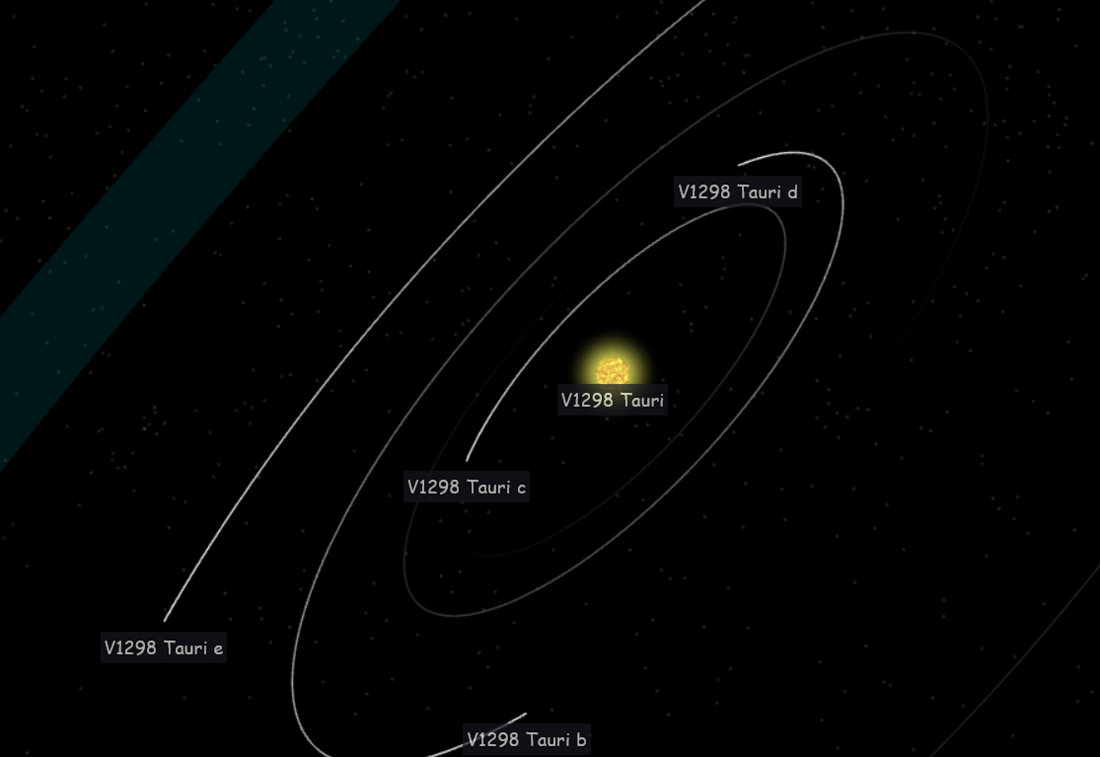Top Qs
Timeline
Chat
Perspective
V1298 Tauri
Star in the constellation Taurus From Wikipedia, the free encyclopedia
Remove ads
V1298 Tauri is a young (23±4 Myr) weakly-lined T Tauri star[5] that is part of the Taurus-Auriga association in the Taurus Molecular Cloud. Alternatively it is part of a proposed moving group, called Group 29 (or 93 Tau group) that is slightly older.[6][7][3][8] The system has four transiting exoplanets, discovered with the Kepler space telescope in the K2 mission.[5] One of the planets was discovered in August 2019[3] and the other three were discovered in November 2019 by the same team.[5]
Remove ads
Stellar characteristics

V1298 Tauri has a spectral type of K0 - K1.5 and it has a mass of about 1.1 M☉. The star appears in x-rays from ROSAT data and it does show strong lithium absorption lines, both signatures of youth and therefore it was a proposed member of Taurus-Auriga. On the other hand it does not show signs of accretion and it lacks infrared excess. Instead it shows H-alpha in absorption.[3]
In 2007, Konstantin Nikolaevich Grankin et al. announced their discovery that V1298 Tauri is a variable star.[9] It was given its variable star designation in 2011.[10] The brightness of V1298 Tauri varies in an unpredictable way between a maximum visual magnitude of 10.31 and a minimum of 10.54.[2] The light curve of the star shows quasi-periodic variability that was interpreted as stellar rotation and starspots. The light curve also showed several flares.[3]
Based on Gaia DR2 data this star is part of a co-moving pair, together with HD 284154.[6] The star is included in an analysis of the 93 Tau group, which finds an age of 35 ±5 Myrs.[8]
Remove ads
Planetary system
Summarize
Perspective
V1298 Tauri has four confirmed planets of which planets c, d and b are near a 1:2:3 resonance (with periods of 8.25, 12.40 and 24.14 days). Planet e only shows a single transit in the K2 light curve and has a period larger than 36 days. Planet e might be in a low-order resonance (of 2:3, 3:5, 1:2, or 1:3) with planet b. The system is very young and might be a precursor of a compact multiplanet system. The 2:3 resonance suggests that some close-in planets may either form in resonances or evolve into them on timescales of less than 10 Myr. The planets in the system have a size between Neptune and Saturn. Only planet b has a size similar to Jupiter.[5]
Models predict that the planets have a minimum core mass of 5 M🜨 and are surrounded by a thick envelope that make up 20% of their mass. The total mass of planet c and d was predicted to be 2 - 28 M🜨 and the total mass of planet d and b was predicted to be 9 - 120 M🜨.[5] In a follow-up paper the mass of V1298 Tauri b was constrained to <2.2 MJ.[11] The planet c was suspected to be shedding mass due to intense irradiation by the host star, but hydrogen tail existence was refuted by 2021.[12]
Orbits of the planets b and c are nearly coplanar and planet c is not inclined to the equatorial plane of the star, misalignment equals to 2+12
−4 degrees.[13]
Planet b was observed with Hubble WFC3 and a transmission spectrum was produced. This observation found a clear primordial atmosphere and water vapor absorption. The mass was constrained from this observation to less than 23 earth-masses, making this planet one of the lowest density planet observed. The team retrieved a low metallicity for the atmosphere, challenging formation mechanisms. The planet will likely evolve into a sub-Neptune in the future.[14] Comparison between the transmission spectrum of planet b and a newly obtained WFC3 transmission spectrum for planet c found that planet b has a large, haze-free envelope. For planet c hazes could not be ruled out. The masses were constrained for planet b to below 20 earth masses and for planet c to 17+13
−6 earth masses. An ongoing transit-timing variation study suggest that both planet b and c are in the mass range of super-Earth to sub-Neptune planets and will evolve into these types of planet.[15]
Planet e could be a planet with a water-rich core and an substantial hydrogen envelope.[16] Planet e was possibly detected by Kepler, TESS and CHEOPS in three transits with an orbital period of around 45 days. The transits have different depths, lengths and maybe has TTVs of a few hours. Alternatively CHEOPS could have detected a fifth planet.[17]
Remove ads
See also
- List of nearby stellar associations and moving groups
- List of exoplanets discovered in 2019
- Kepler-223 - the first confirmed system with four exoplanets in resonance
- K2-138 - a system with five exoplanets in a 3:2 resonance chain
- HD 110067 - a system with seven planets in orbital resonance
References
Wikiwand - on
Seamless Wikipedia browsing. On steroids.
Remove ads

